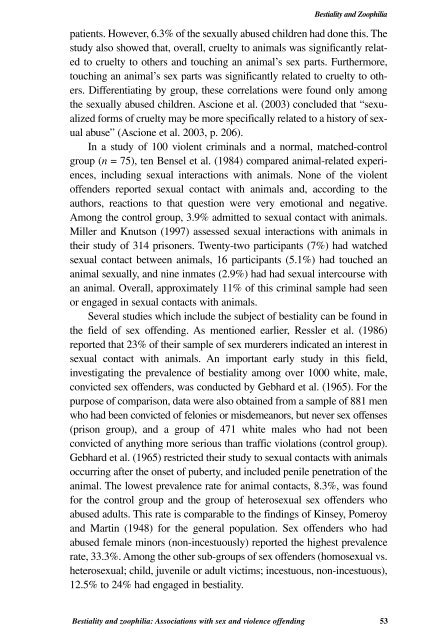Bestiality and zoophilia - Evolve For Animals
Bestiality and zoophilia - Evolve For Animals
Bestiality and zoophilia - Evolve For Animals
You also want an ePaper? Increase the reach of your titles
YUMPU automatically turns print PDFs into web optimized ePapers that Google loves.
<strong>Bestiality</strong> <strong>and</strong> Zoophiliapatients. However, 6.3% of the sexually abused children had done this. Thestudy also showed that, overall, cruelty to animals was significantly relatedto cruelty to others <strong>and</strong> touching an animal’s sex parts. Furthermore,touching an animal’s sex parts was significantly related to cruelty to others.Differentiating by group, these correlations were found only amongthe sexually abused children. Ascione et al. (2003) concluded that “sexualizedforms of cruelty may be more specifically related to a history of sexualabuse” (Ascione et al. 2003, p. 206).In a study of 100 violent criminals <strong>and</strong> a normal, matched-controlgroup (n = 75), ten Bensel et al. (1984) compared animal-related experiences,including sexual interactions with animals. None of the violentoffenders reported sexual contact with animals <strong>and</strong>, according to theauthors, reactions to that question were very emotional <strong>and</strong> negative.Among the control group, 3.9% admitted to sexual contact with animals.Miller <strong>and</strong> Knutson (1997) assessed sexual interactions with animals intheir study of 314 prisoners. Twenty-two participants (7%) had watchedsexual contact between animals, 16 participants (5.1%) had touched ananimal sexually, <strong>and</strong> nine inmates (2.9%) had had sexual intercourse withan animal. Overall, approximately 11% of this criminal sample had seenor engaged in sexual contacts with animals.Several studies which include the subject of bestiality can be found inthe field of sex offending. As mentioned earlier, Ressler et al. (1986)reported that 23% of their sample of sex murderers indicated an interest insexual contact with animals. An important early study in this field,investigating the prevalence of bestiality among over 1000 white, male,convicted sex offenders, was conducted by Gebhard et al. (1965). <strong>For</strong> thepurpose of comparison, data were also obtained from a sample of 881 menwho had been convicted of felonies or misdemeanors, but never sex offenses(prison group), <strong>and</strong> a group of 471 white males who had not beenconvicted of anything more serious than traffic violations (control group).Gebhard et al. (1965) restricted their study to sexual contacts with animalsoccurring after the onset of puberty, <strong>and</strong> included penile penetration of theanimal. The lowest prevalence rate for animal contacts, 8.3%, was foundfor the control group <strong>and</strong> the group of heterosexual sex offenders whoabused adults. This rate is comparable to the findings of Kinsey, Pomeroy<strong>and</strong> Martin (1948) for the general population. Sex offenders who hadabused female minors (non-incestuously) reported the highest prevalencerate, 33.3%. Among the other sub-groups of sex offenders (homosexual vs.heterosexual; child, juvenile or adult victims; incestuous, non-incestuous),12.5% to 24% had engaged in bestiality.<strong>Bestiality</strong> <strong>and</strong> <strong>zoophilia</strong>: Associations with sex <strong>and</strong> violence offending 53


